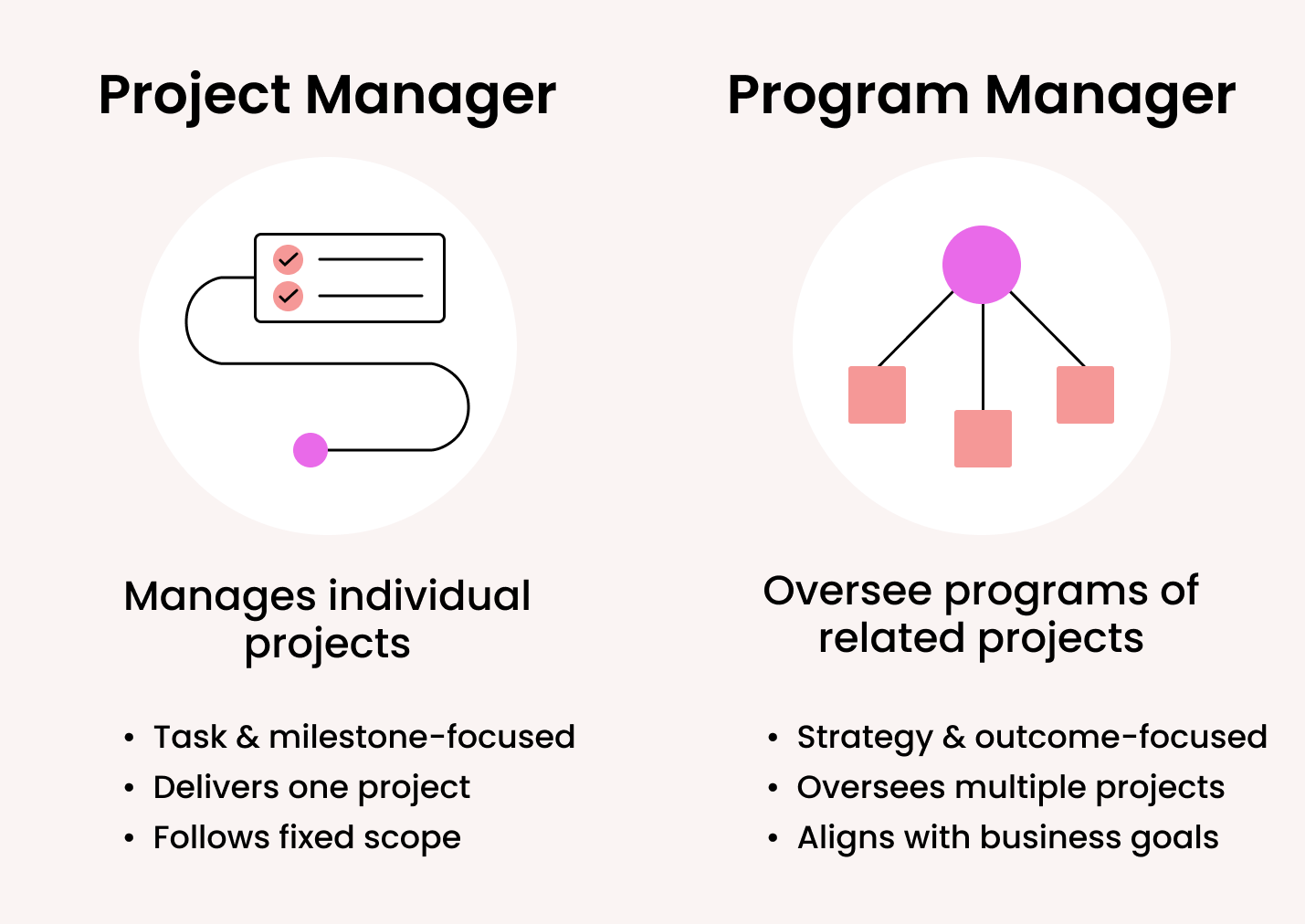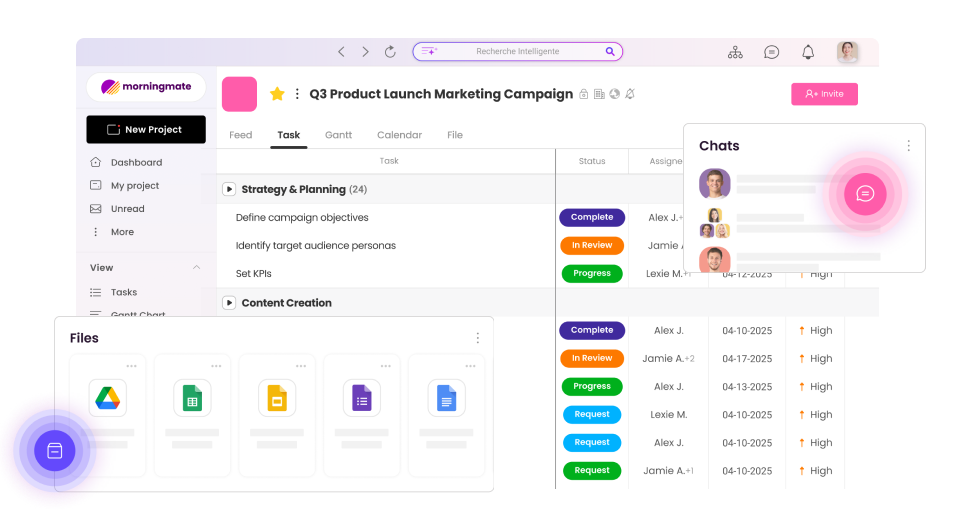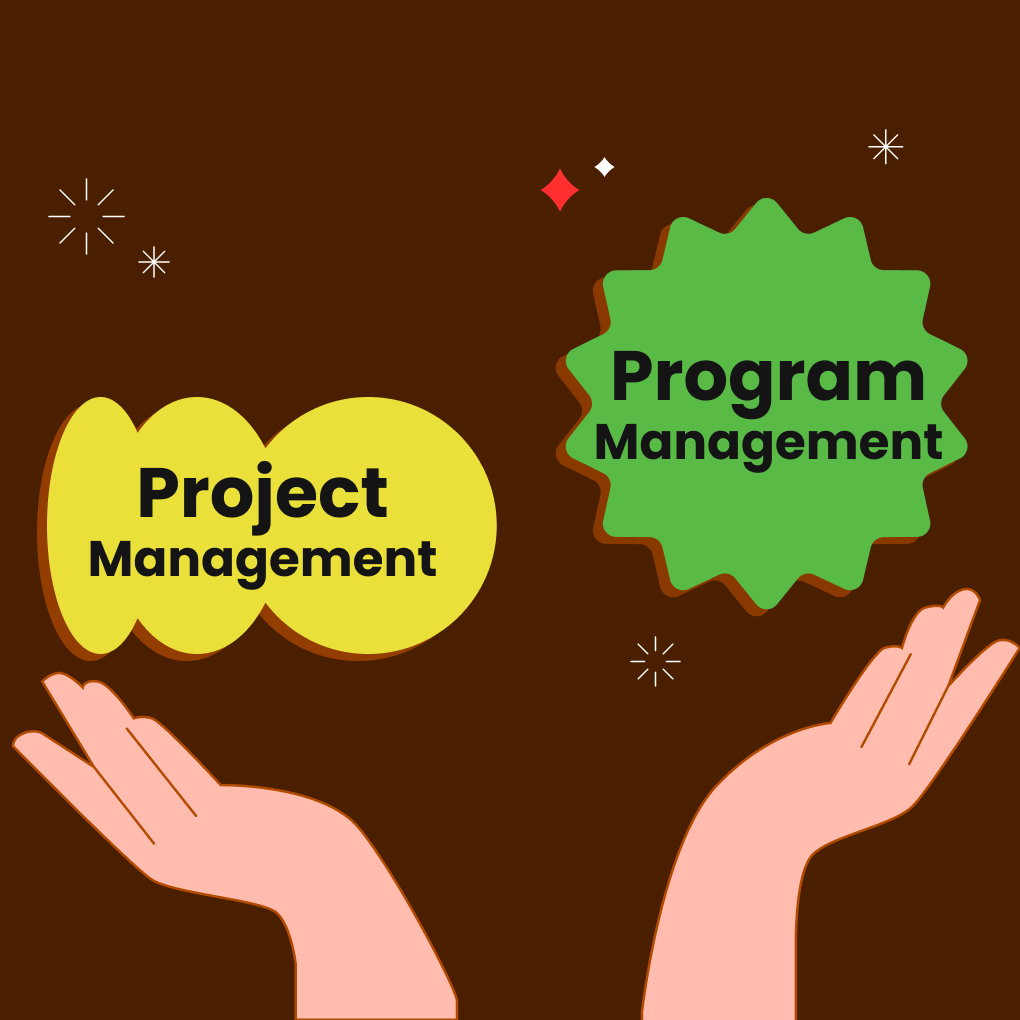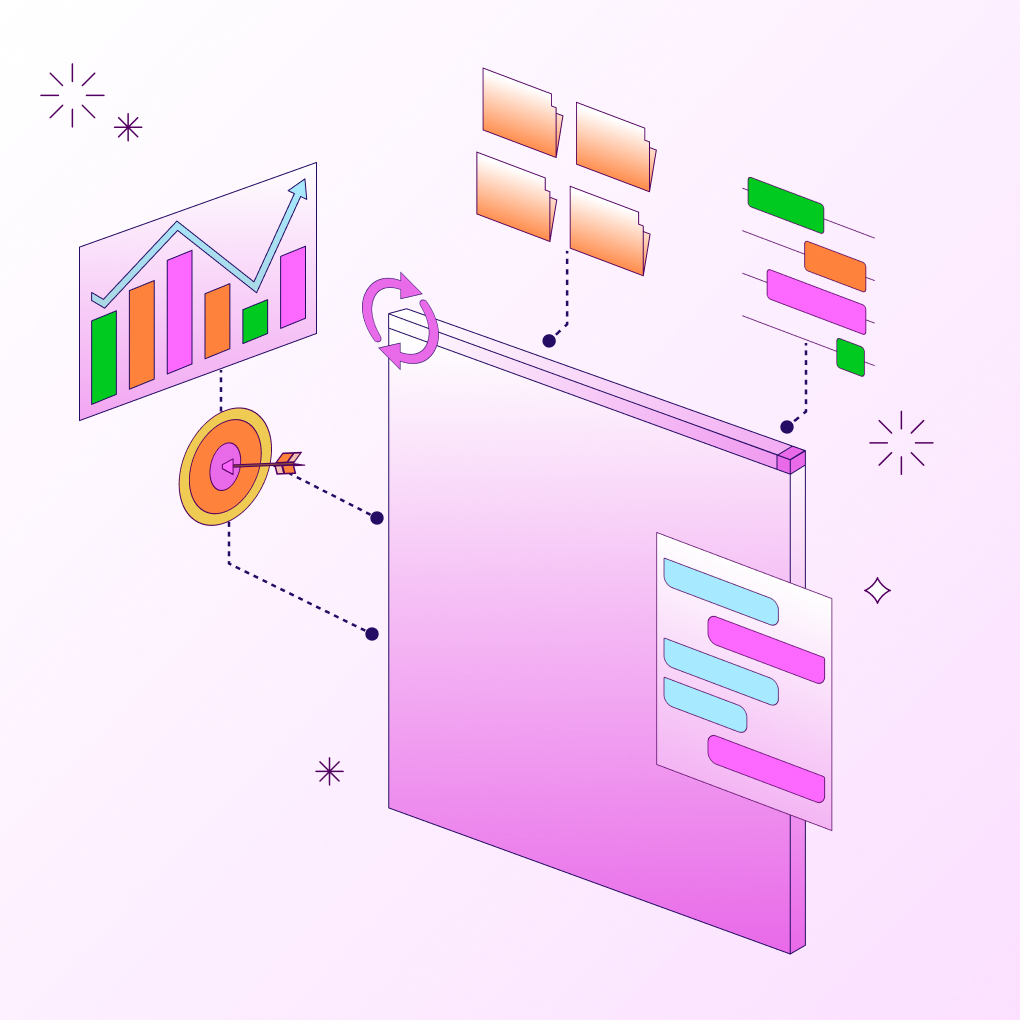Project management or Program management? Project Manager or Program Manager? Deliverable or Benefit? If you have ever felt confused by the terms organizations use to manage work, you are not alone. While “project” and “program” may sound similar and are often used interchangeably, mixing them up can lead to unclear strategies, poor leadership, and stalled progress. Understanding the important difference between program and project management is not just a matter of words; it is essential for organizing work effectively, empowering the right leaders, and achieving your key strategic goals. Although both involve planning and execution, they function on different levels and have distinct purposes.
This guide will explore the differences between program management and project management. We will define what projects and programs are, highlight their key differences, and examine the specific roles, responsibilities, and skills of the Program Manager and Project Manager. Additionally, we will provide examples to clarify the distinction between programs and projects. We will also look at tools that support both roles, such as Morningmate, and discuss how to decide whether your initiative needs a project manager or a program manager.
What Is Project Management vs. Program Management?
The key difference between a project and a program lies in their scope and management.
A project is a temporary effort aimed at producing a unique product, service, or result. It has a defined scope with specific goals, a distinct start and end date, and focuses on delivering unique outcomes. Projects operate under resource constraints, managing time, budget, and available resources. Project Management involves applying knowledge and skills to meet project requirements while effectively managing these constraints.
In contrast, a program consists of a group of related projects managed in a coordinated manner to achieve benefits that wouldn’t be possible if managed separately. Programs align with broader business objectives and are characterized by interdependent projects that contribute to a common goal, delivering greater collective value. They typically have a longer duration and may evolve as strategic priorities change. The success of a program is measured by the realization of strategic value rather than just project outputs, often involving greater complexity and uncertainty compared to individual projects.
Program Management involves using knowledge and skills to achieve a program’s goals and benefits that individual project management cannot. It includes managing multiple projects, their interdependencies, stakeholder communications, and focusing on long-term value.
Key Differences Between Program and Project Management
While both project and program management involve overseeing work, they differ in several important ways:
Goals and Objectives
- Project Management: This focuses on delivering specific, tangible results within set limits, such as scope, time, and cost. The main goal is to successfully complete a unique project. Example: Launch a new mobile app feature by Q3.
- Program Management: This aims at achieving broader strategic goals and delivering long-term business benefits by coordinating multiple projects. The focus is on the overall value and strategic impact of the program. Example: Increase mobile platform user engagement by 20% over the next year, which may include projects for new features, performance improvements, and marketing campaigns.
Scope and Deliverables
- Project Management: This manages a clearly defined scope with specific, often technical, deliverables. Changes to the scope are carefully controlled.
- Program Management: This oversees a larger, potentially changing scope that aligns with strategic goals. It integrates deliverables from various projects to achieve the overall benefits of the program. Changes in scope may occur more frequently as the program adapts to strategic shifts.
Management Style
- Project Management: This is more tactical and focused on execution. It involves detailed task management, scheduling, resource allocation for specific tasks, risk management at the project level, and ensuring the project team delivers the expected results.
- Program Management: This is more strategic and involves coordination. It oversees multiple project managers, manages interdependencies between projects, allocates resources across projects, addresses program-level risks and issues, engages with stakeholders at a higher level, and ensures the program aligns with organizational strategy.
Timeframe and Complexity
- Project Management: This deals with shorter, defined timeframes marked by specific start and end dates. Complexity is usually contained within the project’s defined scope.
- Program Management: This operates over longer periods, often spanning several years, and may not have a fixed end date if tied to ongoing strategic initiatives. It handles greater complexity due to managing multiple interconnected projects, diverse stakeholders, and alignment with changing business strategies.
Role of a Project Manager
The Project Manager (PM) leads a team to achieve specific project goals within defined constraints. They are tactical implementers focused on completing the project.
Responsibilities
A Project Manager’s duties center on successfully executing a single project. This includes careful planning, where they create a detailed project plan covering scope, schedule, budget, and resources. During execution, they guide the team to perform the necessary work. A key aspect is monitoring and controlling, which involves tracking progress, managing changes, identifying and addressing risks, resolving issues, and ensuring quality standards are met. Effective communication is crucial to keep the team and stakeholders informed. They also manage resources, assigning tasks and overseeing the personnel and tools used in the project. Project-specific risk management, including identifying, analyzing, and planning responses to risks, is part of their role. Finally, the PM handles project closing, which includes finalizing activities, archiving documents, and facilitating lessons learned.
Required Skills
To succeed, Project Managers need a mix of organizational and interpersonal skills. Strong organizational skills are essential for managing tasks, schedules, and resources. Leadership is necessary to guide and motivate the team. Clear communication, both written and verbal, is vital for conveying information effectively. Problem-solving skills help in identifying and resolving issues. Proactive risk management involves anticipating potential problems and planning responses. Effective time management ensures realistic schedules are created and maintained, while budget management skills are needed for tracking costs. Often, technical knowledge relevant to the project’s field is beneficial. Finally, attention to detail ensures tasks meet requirements accurately.
Common Challenges
Project Managers often face challenges that test their skills. Scope creep, or the uncontrolled expansion of project requirements, is a frequent issue. They may struggle with resource constraints, such as limited funding or personnel. Facing unrealistic deadlines adds pressure, while communication breakdowns can lead to misunderstandings. Managing team dynamics, including conflicts and motivation, is another significant challenge. Additionally, the emergence of unforeseen risks can greatly impact schedules and budgets, requiring skilled handling.
Role of a Program Manager
The Program Manager (PgM) operates at a higher strategic level, overseeing a group of related projects to ensure they collectively achieve significant business objectives. They act as strategic coordinators, prioritizing the delivery of overall value.
Responsibilities
A Program Manager’s responsibilities are broader and more strategic than those of a Project Manager. A primary duty is ensuring strategic alignment, making sure the program and its projects support organizational goals. They handle program planning and governance, defining the program’s structure, establishing oversight processes, and creating a high-level roadmap. A key focus is on benefits realization, ensuring the program delivers its intended business value. Dependency management across projects is crucial, as is optimizing resource allocation across the entire program. Stakeholder management involves engaging with senior leaders, sponsors, and Project Managers. They also oversee program-level risk management and financial management for the entire program budget. Change management at the program level and providing project oversight and guidance to individual Project Managers are also core functions.
Required Skills
The skillset for a Program Manager leans more towards strategic and leadership abilities. Strategic thinking is essential for aligning program activities with business goals. Leadership and influence are needed to guide multiple teams and engage senior stakeholders, often without direct authority. Strong financial acumen is required for managing large program budgets. Excellent communication and negotiation skills are vital for dealing with diverse audiences and priorities. Strategic risk management and effective change management capabilities are crucial for navigating long-term initiatives. Furthermore, relationship building with key players, effective conflict resolution between projects or stakeholders, and solid business acumen regarding the organization’s industry and market are critical for success.
Common Challenges
Program Managers face complex challenges inherent in coordinating multiple efforts. Managing interdependencies between projects requires constant attention. Resource conflicts often arise due to competing priorities. Maintaining strategic alignment can be difficult as business goals evolve over the program’s long duration. The complexity of managing stakeholders across various levels and interests is significant. Measuring intangible benefits and proving value realization poses a challenge. Dealing with the inherent ambiguity of long-term strategic initiatives and ensuring consistent governance across diverse project teams are also common hurdles.
Program Manager vs. Project Manager: Side-by-Side Comparison
Understanding the core Program Manager Project Manager difference is easier with a direct comparison.
Job Functions

The key difference between a Project Manager and a Program Manager is their focus. A Project Manager handles specific, temporary projects with set timelines and unique deliverables, measuring success by project completion. In contrast, a Program Manager oversees related projects over a longer period, aiming for broader strategic outcomes and benefits, and measures success by the value delivered to organizational goals.
Collaboration and Overlap
Project Managers and Program Managers collaborate closely, with Program Managers depending on Project Managers to execute individual projects for overall program success. Effective communication is essential, as Program Managers guide and resolve conflicts while Project Managers provide updates and manage daily tasks. Those moving from project to program management must develop a strategic perspective and improve their skills in managing diverse stakeholders and complex interdependencies.
Tools They Use
Both Project Managers and Program Managers rely on software for planning, tracking work, managing resources, and communication, though their focus varies.
Project Managers need tools for detailed task management, scheduling, resource allocation, budget tracking, issue tracking, and team collaboration.
Program Managers require tools for high-level roadmapping, portfolio views, dependency visualization, resource management, program budget oversight, program-level risk management, stakeholder communication, and centralized document management. Each role emphasizes different features to effectively manage their respective responsibilities
Recommended Tool for Both: Morningmate

An integrated, all-in-one workspace like Morningmate can effectively serve both Project and Program Managers. For Project Managers, it offers strong task management capabilities (boards, lists), project-specific communication via its feed-style updates, file sharing, and essential integrations. For Program Managers, Morningmate provides a central hub. Depending on how projects are structured within the platform, it can offer visibility into overall progress through consolidated feeds or reports (potentially enhanced by AI features in paid tiers). The integrated messenger facilitates communication across different project teams, and the platform serves as a central repository for program documentation and stakeholder updates. By embedding communication within the context of work, Morningmate helps bridge the gap between strategic oversight and tactical execution, mitigating the information silos that can arise when using separate tools for project management and chat.
Other widely used tools include Asana, Jira (particularly strong for software development), Monday.com, Smartsheet, and Microsoft Project, each offering different balances between detailed project features and broader program or portfolio management capabilities.
Real-World Examples: Program vs Project
Concrete examples help solidify the difference between project and program.
Example of a Project
- Goal: Develop and launch a new online checkout feature for an e-commerce website by the end of Q2.
- Scope: Design the UI/UX, develop the backend functionality, integrate payment gateways, perform testing, deploy the feature.
- Deliverable: A functional and tested online checkout feature live on the website.
- Managed by: Project Manager.
Example of a Program
- Goal: Enhance the overall online customer experience and increase online sales conversion rate by 15% over 18 months.
- Scope: Includes multiple initiatives aimed at improving the customer journey.
- Component Projects:
- Project: Develop and launch the new online checkout feature (from the example above).
- Project: Implement a customer loyalty points system.
- Project: Redesign the product browsing and search interface.
- Project: Launch targeted email marketing campaigns based on browsing history.
- Project: Improve website loading speed and performance.
- Benefit: Increased customer satisfaction, higher conversion rates, and greater online revenue.
- Managed by: Program Manager.
In this scenario, the Program Manager orchestrates these distinct yet interconnected projects. Their role is to ensure the projects work together harmoniously to achieve the larger strategic objective: improving the customer experience and boosting sales significantly.
How to Choose Between a Program Manager and a Project Manager
Deciding between project and program management depends on the initiative’s complexity, strategic alignment, and scope.
Team Needs
Evaluate the work’s nature and team structure. If the goal is specific, has a clear endpoint, and results in a distinct deliverable, a Project Manager is suitable. They will guide the team through execution. Conversely, if the initiative involves multiple interconnected projects and requires coordination across teams for significant business value over time, a Program Manager is necessary for strategic oversight.
Project vs Organizational Strategy
Assess the initiative’s role in the broader organizational strategy. A self-contained effort typically indicates a project, while an initiative that is part of a larger strategy requiring coordination suggests the need for program management. Programs connect daily project execution with strategic goals, ensuring that combined efforts yield long-term benefits and align with strategic KPIs.
Conclusion
Understanding the difference between program and project management is crucial for effective execution. Project management focuses on delivering specific, temporary initiatives, while program management oversees multiple related projects for long-term benefits. The key differences include scope, focus, timeframe, and management style, which are essential for aligning efforts with organizational goals and ensuring success.




